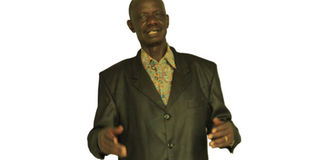I saw the first NRA casualty - Rwakampala

Ex-bush war hero. Sagt (rtd) Sam Rwakampala. PHOTO BY RACHEL MABALA
What you need to know:
- Roles. From seeing the first NRA casualty to joining the war and later becoming a key personnel to the war, Mr Sam Rwakampala narrates to Faustin Mugabe what transpired.
On February 9, 1981, Sergeant (rtd) Sam Rwakampala saw the first casualty of the Popular Resistance Army (PRA) which later became the National Resistance Army (NRA) rebels fighting the Uganda government.
On February 6, 1981 Yoweri Museveni led about 40 other fighters in the attack of Kabamba Barracks in Mubende District.
The rebels captured power on January 26, 1986 and Museveni has since then been Uganda’s only President.
Meanwhile, two days after the war had started, Ugandan and Tanzanian forces that were still in Uganda after the 1979 Liberation War, attacked the rebels at Katera Trading Centre, forcing them to disperse into different directions.
One group went to Mzee Yokana Baraire’s home, a local cattle keeper not so far away from Katera.
Rwakampala witnesses first casualty
“We had heard from the radio that Museveni had gone to the bush. Then on the evening of February 9, 1981, while seeing cows getting into the kraal, we saw the soldiers approaching our home. They were 11. Three of them were armed and dressed in military uniform, while others were in civilian clothes,” Rwakampala says.
“One of them had been shot in the arm and it was wrapped with some cloth. He was dressed in the military uniform. That rebel was David Kayambi,” Rwakampala recalls.
Mr Kayambi was one of the original PRA fighters and was initially in the Uganda National Liberation Army.
Mr Rwakampala says after they had introduced themselves to Mzee Baraire as rebels led by Museveni fighting Milton Obote’s regime, they asked if he had heard of the rebels in the vicinity to which Mzee Baraire answered no.
He adds that they then asked for the location of Mzee Ephraim Kisitu’s home.
“My father told me to lead them to Mzee Kisutu’s home which was about a mile away. I took them. When we reached, Kisitu welcomed them and told them that the colleagues were in the bush nearby. He gave us his son Kaweesi, who took us where others were. That was about 9pm,” Rwakampala says.
After they had attacked, other rebels went to a Munyankore woman called Beatrice Kyamurunga, who hid them.
“Because Kyamurunga and my father had been UPM (Uganda Patriotic Movement members) and I had been involved in registering UPM then with Kyamurunga during the 1980 electioneering, I went to Kyamurunga and asked her if she had heard of the Museveni rebels. She told me that they were around. But she did allow me to go and meet them since it was day time,” he recollects, adding: “That is how we started sending milk and food to them at night.
Museveni’s version
Mr Rwakampala’s assertion corresponds with Museveni’s story in his book Sowing the Mustard Seed.
About the Tanzanians attacking them, he wrote: “on the morning of February 9, I went to Bukomero to do some recruitment and when I came back, I found that a number of Tanzanian soldiers and Uganda recruits had attacked our camp and the group I had left there had been dispersed.”
About 14 days later, Mr Rwakampala says he joined the rebels. Among the people he joined with on that day is Captain (rtd) David Bashaija, the co-founder of Ngabo Academy in Mbarara Town.
Rwakampala was NRA GPS
During the bush war, Mr Rwakampala says he was the rebel’s GPS and only once he led the rebels into a wrong direction.
“It was raining heavily and I could not see the stars in the sky for interpretation. We were coming from attacking Hoima Barracks. We were almost going back to where we had passed. President Museveni called me on radio and it seemed we were going back. He stopped us; came with his compass and re-directed us. But that was the only time in five years that I lost direction,” he says.
Long before the Whites came to Africa, people already knew about astronomy. Mr Rwakampala had learnt it from his father.
He knew how to read and interpret the movement and time of the stars at night. Because of his expertise, he was always the lead person in many of the operations that occurred at night.
Retiring into poverty
In 1993, Mr Rwakampala retired from the army, into poverty.
Today, the man who helped the first wounded NRA rebels locate their lost colleagues and was the NRA’s human GPS, is wallowing in poverty in Kiboga District amid jeers from people who taunt him, asking what he benefitted from fighting Obote’s regime and supporting Museveni’s government.
Mr Rwakampala, whose name means “of Kampala” in Runyankore, was born at New Mulago hospital in Kampala. His father named him after Uganda’s capital city. He was born on July 27, 1957 and he is recorded as No RA: 2971 of the NRA.
KEY DATES
Birth: Rwakampala was born on July 27, 1957.
The start: He was involved in registering UPM members during the 1980 electioneering.
Witness. Rwakampala saw the first NRA casualty on February 9, 1981. He later joined the rebels.
Capture: NRA rebels captured power on January 26, 1986.
Retired: In 1993, Mr Rwakampala retired from the army.




